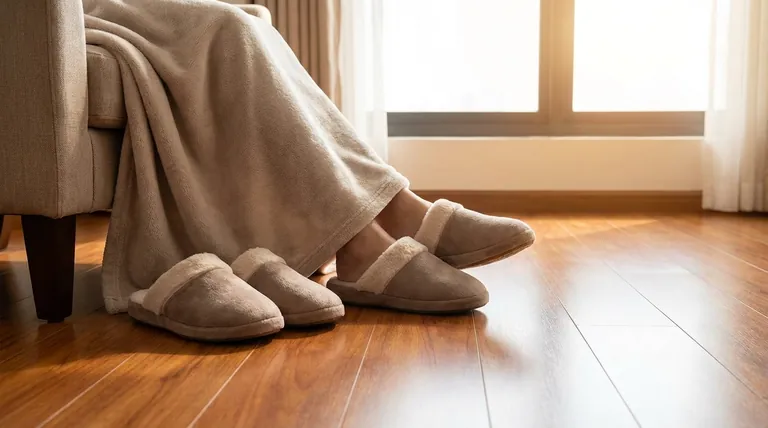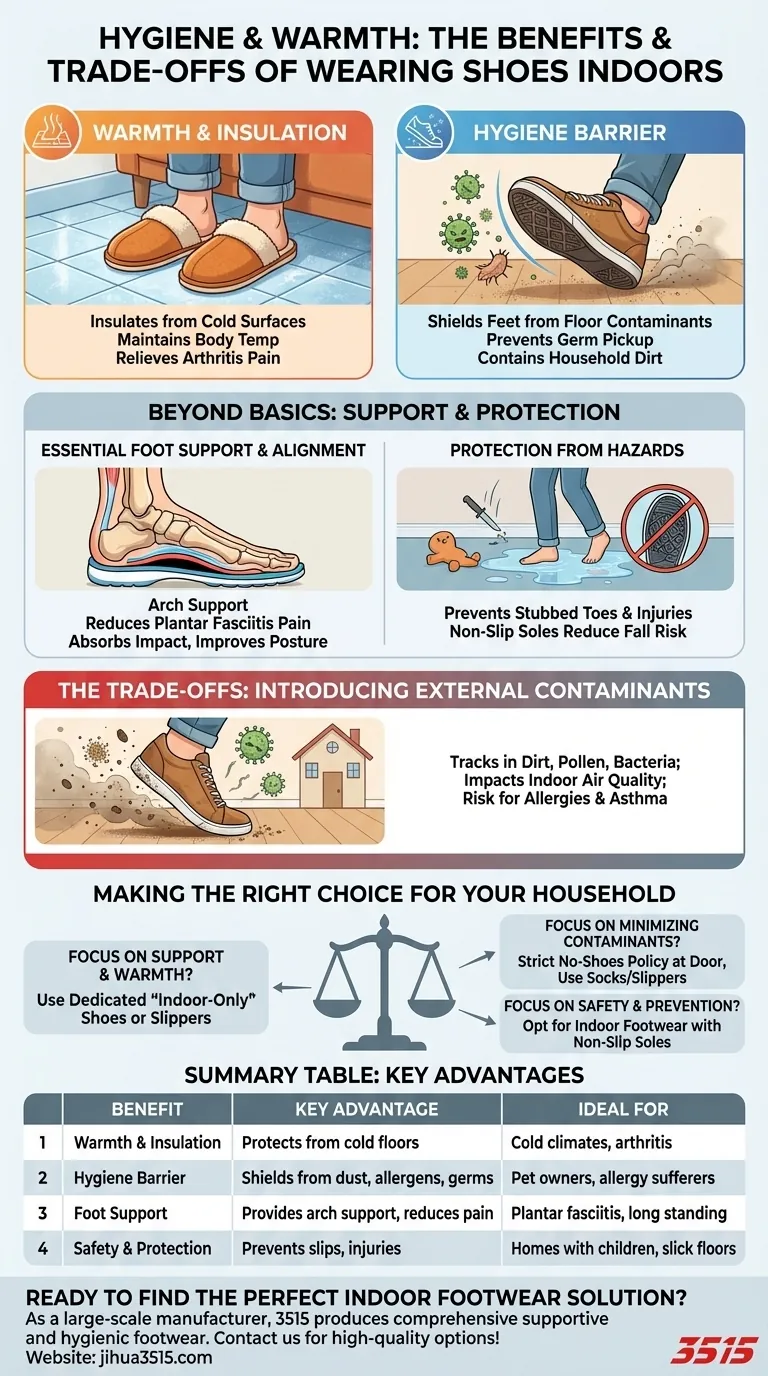From a functional standpoint, wearing shoes indoors provides two primary benefits. They offer a layer of insulation that keeps your feet warm on cold floors, and they create a hygienic barrier that shields your feet from direct contact with dirt, allergens, and germs that accumulate on household surfaces.
The decision to wear shoes inside is a direct trade-off. You gain personal warmth, support, and a barrier against indoor contaminants at the cost of introducing external dirt and pollutants into your home environment.

The Direct Benefits: Warmth and Insulation
Insulating from Cold Surfaces
Shoes act as a crucial barrier between your feet and cold flooring materials like tile, concrete, or hardwood. This insulation helps maintain a comfortable body temperature, especially during colder seasons.
This benefit is particularly valuable for individuals with conditions like arthritis, where cold can exacerbate joint pain and stiffness.
The Hygiene Factor: A Protective Barrier
Shielding Feet from Floor Contaminants
Even clean-looking floors harbor dust, pet hair, stray crumbs, and allergens. Shoes prevent your feet from coming into direct contact with these particles.
This barrier helps maintain better foot hygiene and prevents you from picking up germs that may be present on the floor.
Containing the Spread of Household Dirt
By keeping your feet covered, you also avoid transferring any existing floor residue to other surfaces. This can help keep furniture, like couches or beds, cleaner if you tend to put your feet up.
Beyond Warmth and Hygiene: The Case for Indoor Footwear
Essential Foot Support and Alignment
For many, the most significant benefit is structural support. Shoes with proper cushioning and arch support can dramatically reduce foot pain, especially for those with conditions like plantar fasciitis.
Standing or walking on hard indoor surfaces for long periods puts stress on your joints. Supportive footwear absorbs impact, improves posture, and can help alleviate related back pain.
Protection from Household Hazards
Shoes provide a physical shield against common household injuries. They can protect you from stubbing your toe on furniture or stepping on a sharp object like a stray toy.
Furthermore, footwear with non-slip soles significantly reduces the risk of falls on slick surfaces like a recently cleaned kitchen floor.
Understanding the Trade-offs: What Shoes Bring Inside
Introducing External Contaminants
The most significant downside to wearing outdoor shoes inside is what they track in. Soles can carry everything from visible dirt and pollen to unseen bacteria and chemicals from sidewalks and lawns.
Impact on Air Quality and Health
These external pollutants can degrade your home's indoor air quality. This poses a particular risk for individuals with allergies or asthma.
It's also a concern for households with young children or pets who spend a significant amount of time on the floor, increasing their exposure to these contaminants.
The Cultural Context
The practice of wearing shoes indoors is not universal. In many cultures, removing shoes is a sign of respect for the home and a practical measure to maintain cleanliness, highlighting that there is no single correct approach.
Making the Right Choice for Your Household
Deciding whether to wear shoes indoors requires balancing your personal needs for support and comfort against your goals for home cleanliness.
- If your primary focus is foot support and warmth: Consider using a dedicated pair of "indoor-only" shoes or supportive slippers to get the benefits without tracking in outside dirt.
- If your primary focus is minimizing outside contaminants: Implement a strict no-shoes policy at the door and encourage the use of socks or slippers instead.
- If your primary focus is safety and injury prevention: Opt for indoor footwear with non-slip soles, especially if your home has many hard, potentially slippery surfaces.
Ultimately, the best approach is the one that aligns with your family's health needs, comfort, and the unique environment of your home.
Summary Table:
| Benefit | Key Advantage | Ideal For |
|---|---|---|
| Warmth & Insulation | Protects feet from cold floors | Cold climates, individuals with arthritis |
| Hygiene Barrier | Shields feet from dust, allergens, and germs | Households with pets, allergy sufferers |
| Foot Support | Provides arch support, reduces pain | Those with plantar fasciitis, standing for long periods |
| Safety & Protection | Prevents slips and injuries from sharp objects | Homes with children, slick floors |
Ready to find the perfect indoor footwear solution for your needs?
As a large-scale manufacturer, 3515 produces a comprehensive range of supportive and hygienic footwear for distributors, brand owners, and bulk clients. Whether you need comfortable slippers with arch support or durable indoor shoes with non-slip soles, our production capabilities encompass all types of shoes and boots to meet your specific requirements.
Contact us today to discuss how we can provide high-quality, beneficial footwear for your customers or organization!
Visual Guide

Related Products
- Safety Footwear Wholesale Manufacturer for Custom OEM/ODM Production
- Durable Rubber-Soled Utility Shoes for Wholesale & Custom Brand Manufacturing
- Wholesale Safety Footwear Manufacturer for Bulk & Custom OEM Orders
- Premium KPU Injection Athletic Style Safety Shoes
- Wholesale Durable Breathable Safety Boots Custom OEM Manufacturer
People Also Ask
- Is it normal to wear shoes in the house? A Guide to Hygiene, Comfort & Culture
- What are the differences between steel toe, composite toe, and alloy toe Wellington boots? Choose the Right Safety Toe for Your Job
- What do heavy duty boots do? Protect Your Feet in Demanding Work Environments
- What are the cultural perspectives on wearing shoes in the house? A Guide to Home Etiquette & Hygiene
- Do snake bite boots work? Your Ultimate Guide to Effective Snake Bite Protection



















